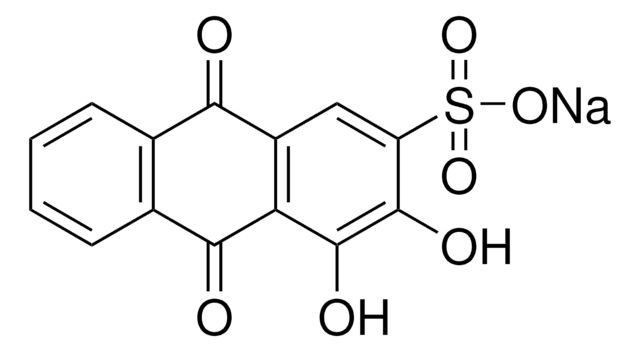AB139
Anti-Glycine Antibody
serum, Chemicon®
Se connecterpour consulter vos tarifs contractuels et ceux de votre entreprise/organisme
About This Item
Code UNSPSC :
12352203
eCl@ss :
32160702
Nomenclature NACRES :
NA.41
Produits recommandés
Source biologique
rabbit
Niveau de qualité
Forme d'anticorps
serum
Type de produit anticorps
primary antibodies
Clone
polyclonal
Espèces réactives
rat
Fabricant/nom de marque
Chemicon®
Technique(s)
immunohistochemistry: suitable
Conditions d'expédition
dry ice
Modification post-traductionnelle de la cible
unmodified
Spécificité
Glycine
The cross-reactivities were determined using either ELISA or RIA techniques, at concentration/unconjugated or conjugated amino acid concentration at half displacement.
Compound Cross-reactivity
Glycine-G-BSA 1
Beta Alanine-G-BSA 1/100
GABA-G-BSA 1/500
Taurine-G-BSA 1/1000
Aspartate-G-BSA 1/20000
Glutamate-G-BSA <1/20000
Glycine <1/50000
The antisera was also tested for specificity using the free-floating PAP technique on rat spinal cord.
Abbreviations:
(G) Glutaraldehyde
(BSA) Bovine Serum Albumin
The cross-reactivities were determined using either ELISA or RIA techniques, at concentration/unconjugated or conjugated amino acid concentration at half displacement.
Compound Cross-reactivity
Glycine-G-BSA 1
Beta Alanine-G-BSA 1/100
GABA-G-BSA 1/500
Taurine-G-BSA 1/1000
Aspartate-G-BSA 1/20000
Glutamate-G-BSA <1/20000
Glycine <1/50000
The antisera was also tested for specificity using the free-floating PAP technique on rat spinal cord.
Abbreviations:
(G) Glutaraldehyde
(BSA) Bovine Serum Albumin
Immunogène
Glycine-gluteraldehyde-BSA
Application
Immunohistochemistry: 1:500-1:2,500 by PAP (see suggested protocol).
Optimal working dilutions must be determined by the end user.
Optimal working dilutions must be determined by the end user.
Research Category
Neuroscience
Neuroscience
Research Sub Category
Neurotransmitters & Receptors
Neurotransmitters & Receptors
This Anti-Glycine Antibody is validated for use in IH for the detection of Glycine.
Forme physique
Rabbit antiserum. Liquid with 0.05% sodium azide.
Stockage et stabilité
Maintain at -20°C in undiluted aliquots for up to 6 months after date of receipt. Avoid repeated freeze/thaw cycles.
Informations légales
CHEMICON is a registered trademark of Merck KGaA, Darmstadt, Germany
Clause de non-responsabilité
Unless otherwise stated in our catalog or other company documentation accompanying the product(s), our products are intended for research use only and are not to be used for any other purpose, which includes but is not limited to, unauthorized commercial uses, in vitro diagnostic uses, ex vivo or in vivo therapeutic uses or any type of consumption or application to humans or animals.
Vous ne trouvez pas le bon produit ?
Essayez notre Outil de sélection de produits.
Code de la classe de stockage
10 - Combustible liquids
Classe de danger pour l'eau (WGK)
WGK 2
Certificats d'analyse (COA)
Recherchez un Certificats d'analyse (COA) en saisissant le numéro de lot du produit. Les numéros de lot figurent sur l'étiquette du produit après les mots "Lot" ou "Batch".
Déjà en possession de ce produit ?
Retrouvez la documentation relative aux produits que vous avez récemment achetés dans la Bibliothèque de documents.
Interruption of pacemaker signals is mediated by GABAergic inhibition of the pacemaker nucleus in the African electric fish Gymnarchus niloticus.
Ying Zhang, Masashi Kawasaki
Journal of comparative physiology. A, Neuroethology, sensory, neural, and behavioral physiology null
S McDavid et al.
Neuroscience, 139(3), 1049-1059 (2006-03-15)
Three series of experiments were carried out to characterize interneurons located within the trigeminal motor nucleus of young rats aged 5-24 days. Cholera toxin injections were made bilaterally into the masseter and, sometimes, digastric muscles to label motoneurons. In the
Atsuo Nishino et al.
BMC neuroscience, 11, 6-6 (2010-01-21)
Rhythmic motor patterns for locomotion in vertebrates are generated in spinal cord neural networks known as spinal Central Pattern Generators (CPGs). A key element in pattern generation is the role of glycinergic synaptic transmission by interneurons that cross the cord
Heterogeneous kinetics and pharmacology of synaptic inhibition in the chick auditory brainstem.
SP Kuo, LA Bradley, LO Trussell
The Journal of Neuroscience null
J H Lue et al.
Synapse (New York, N.Y.), 41(2), 139-149 (2001-06-16)
This study was aimed to clarify whether the primary afferent terminals (PATs), GABAergic terminals, and glutamatergic terminals made direct synaptic contacts with glycine-IR neurons in the cuneate nucleus of rats. In this connection, injection of the anterograde tracer WGA-HRP into
Notre équipe de scientifiques dispose d'une expérience dans tous les secteurs de la recherche, notamment en sciences de la vie, science des matériaux, synthèse chimique, chromatographie, analyse et dans de nombreux autres domaines..
Contacter notre Service technique




